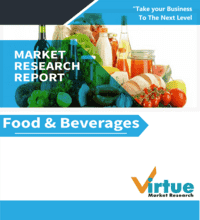Meat & Meat Products Market Size (2025 – 2030)
The Global Meat & Meat Products Market was valued at USD 1460 billion in 2024 and is projected to reach a market size of USD 2101.6 billion by the end of 2030. Over the forecast period of 2025-2030, the market is projected to grow at a CAGR of 7.55%.
Meat products are those food products that are slaughtered and utilized for human consumption by processing and preserving meat through smoking, salting, fermenting, or by using any chemicals. The principal meat products are pork, mutton, beef, and others. The swine flesh, when dressed for consumption and fresh or salted, is pork. The various products are chilled, frozen, canned/preserved, and of various natures like organic and conventional. It is distributed through various channels like supermarkets and hypermarkets, convenience stores, E-Commerce, and other distribution channels.
Key Market Insights:
- 70% of global meat consumption is dominated by pork and poultry, with poultry alone contributing to over 35% due to affordability and fewer cultural restrictions.
- Over 80 billion animals are slaughtered globally each year for meat, with China, the U.S., and Brazil being the top three producers. Processed meat accounts for nearly 50% of global packaged meat sales, driven by consumer demand for convenience and longer shelf life.
- 70% of global consumers are actively seeking clean-label and antibiotic-free meat, indicating a strong preference for transparency and health-conscious choices. The plant-based meat alternatives market has grown by 30% year-over-year, with nearly 42% of consumers worldwide reducing meat intake or going flexitarian.
Global Meat & Meat Products Market Drivers:
The increasing global population, projected to reach nearly 10 billion by 2050, is driving a significant surge in protein consumption.
The increasing global population, which is expected to reach almost 10 billion by 2050, is fueling a huge increase in protein consumption. With rising disposable incomes, particularly in emerging markets, there is a perceptible shift in food habits from cereal-based to protein-based diets, including meat and meat products. The process of urbanization and the expansion of middle-class populations are key drivers, facilitating greater access to modern retailing environments, cold storage, and processed meat alternatives. Consumers exhibit an increasing demand for convenient, ready-to-cook meat products, which in turn fuels demand. Meat remains widely perceived as a fundamental source of complete proteins, essential amino acids, and essential nutrients and, hence, a desirable food choice across the world. Globalization has also facilitated the diversification of meat choices across geographies and cultures, with local preferences shaping international consumption patterns. Even with the rise of plant-based alternatives, animal-based meat remains the dominant global protein consumption pattern. Therefore, the increasing global demand for healthy, protein-rich food is one of the most compelling drivers of the meat market.
Innovations in meat processing, packaging, and preservation have significantly boosted the growth of the meat and meat products market.
Meat processing, packaging, and preservation technologies have also played a pivotal role in boosting the meat and meat products market. Technological advancements such as vacuum packing, modified atmosphere packaging (MAP), and modern cold storage technology have increased the shelf life of processed and fresh meat. These technologies minimize spoilage, ensure safety, and make meat constantly available over distances. Slaughterhouse and processing plant automation and AI have streamlined efficiency and hygiene to meet growing global demand. Traceability and intelligent labeling also enable consumers to identify the source and quality of meat products, increasing trust and brand loyalty. Clean-label principles and natural preservation methods such as HPP (high-pressure processing) are also increasing. As grocery delivery and online shopping increase, these technologies make safe and fresh meat delivery available at consumers' doorsteps. Tech-enabled efficiency and safety features together are vital in maintaining the rising trend in the market.
Global Meat & Meat Products Market Restraints and Challenges:
One of the major restraints facing the global meat and meat products market is the growing awareness of environmental, ethical, and animal welfare concerns.
One of the key constraints against the meat and meat products market globally is the increasing awareness of environmental, ethical, and animal welfare issues. Cattle meat production, in particular, is a major cause of greenhouse gas emissions, water usage, and forest destruction. The research into livestock production being linked to global warming has ignited widespread debates and criticism, particularly from environmental activists and health-oriented consumers. Moreover, worries regarding factory farming methods, animal abuse, and excessive use of antibiotics in livestock are prompting increasing numbers of individuals to cut down on meat consumption or opt for plant-based or cultured alternatives. This consumer trend is especially pronounced among younger generations, such as Millennials and Gen Z. Regulatory pressures regarding emissions and animal welfare standards are also constricting in most regions. These factors combined present a challenge to conventional meat producers, compelling the industry to innovate, invest in sustainable production, and adapt to shifting consumer values.
Global Meat & Meat Products Market Opportunities:
The meat market worldwide is seeing thrilling possibilities through the advent of alternative proteins and value-added, premium meats. Increased demand from consumers regarding health, sustainability, and ethical eating has paved the way for plant-based meat, lab/cultured meat, and hybrid meat options combining traditional and alternative proteins. Not only are these solutions aimed at environmental care, but also flexitarians, or customers who are not completely vegetarian but knowingly limit the use of meat. Also, there is an increasing need for organic, grass-fed, antibiotic-free, and traceable meat, particularly in developed economies. High-quality meat cuts, ready-to-cook gourmet meat products, and functional meats with enhanced health benefits (such as omega-3 enriched) are becoming increasingly popular. Developments in food tech, investments by large players, and government initiatives are further fueling innovation and market growth. These changing tastes offer a gigantic growth potential for brands that match up with forward-looking protein trends.
MEAT & MEAT PRODUCTS MARKET REPORT COVERAGE:
|
REPORT METRIC |
DETAILS |
|
Market Size Available |
2024 - 2030 |
|
Base Year |
2024 |
|
Forecast Period |
2025 - 2030 |
|
CAGR |
7.55% |
|
Segments Covered |
By Animal Type, meat type, and Region |
|
Various Analyses Covered |
Global, Regional & Country Level Analysis, Segment-Level Analysis, DROC, PESTLE Analysis, Porter’s Five Forces Analysis, Competitive Landscape, Analyst Overview on Investment Opportunities |
|
Regional Scope |
North America, Europe, APAC, Latin America, Middle East & Africa |
|
Key Companies Profiled |
JBS S.A., Tyson Foods Inc, Cargill Inc, WH Group Limited, and Danish Crown A/S |
Global Meat & Meat Products Market Segmentation:
Meat & Meat Products Market Segmentation: By Animal Type
- Beef
- Pork
- Poultry
- Others
Market segmentation by animal type captures unique consumer tastes, cultural consumption habits, and local supply chains. Poultry remains predominant worldwide because of its affordability, lower fat levels, and fewer religious taboos. Pork is greatly consumed in Europe and East Asia, particularly in nations such as China and Germany. Beef continues to be the staple of North and South American cuisines, led by both food service and household demand, while its cost and environmental footprint restrict growth in some markets. Mutton, goat meat, and exotic meats fall under the 'Others' category, with niche but increasing popularity in some regions, mainly the Middle East and Africa. Income levels also shape consumption patterns by animal type, as do dietary trends and changing health awareness.
Meat & Meat Products Market Segmentation: By Meat Type
- Processed
- Canned/Preserved
- Chilled
- Fresh
The meat market is also segmented by type, each serving particular lifestyles and tastes. Processed meat—such as sausages, bacon, and deli cuts—holds a significant share because of its convenience, longer shelf life, and availability in fast-food chains. Canned/preserved meat enjoys steady demand in areas with limited access to cold chains or in times of emergencies and military applications. Refrigerated meat is picking up pace, particularly in urban centers with sophisticated refrigeration facilities and increasing consumer demand for fresher, ready-to-cook products. Fresh meat continues to be a household favorite in most homes, particularly in developing countries, because it is affordable and preferred for daily or weekly purchases from local butchers or wet markets. Each appeals to different market segments based on income, culture, and infrastructure.
Meat & Meat Products Market Segmentation: Regional Analysis:
- North America
- Asia-Pacific
- Europe
- South America
- Middle East & Africa
The regional breakdown of the global meat and meat products market indicates robust consumption and production dynamics in important regions. The market is dominated by Asia-Pacific, driven by immense demand in China and India, where meat demand has been gradually increasing with changes in lifestyle and food patterns. North America comes next, driven by the U.S., a leading consumer and producer of beef and chicken. In Europe, pork leads the meat category with the backing of a highly developed meat processing sector. South America, especially Brazil and Argentina, leads with its strong beef exports, which are key to the world's supply chain. The Middle East and Africa, on the other hand, are experiencing increased demand, fueled by rising urbanization, ascending incomes, and a high affinity for halal-approved meat products.
COVID-19 Impact Analysis on the Global Meat & Meat Products Market:
The COVID-19 pandemic severely impacted the international meat and meat products market, revealing weaknesses throughout the supply chain. Lockdowns, labor shortages, and plant closures resulted in lower production capacity and supply bottlenecks. Export bans and transport restrictions further slowed shipments, leading to price volatility and stock shortages in various regions. Consumer consumption changed as well, with a higher demand for packaged, frozen, and shelf-stable meat products because of panic purchases and home isolation. Foodservice and hospitality industries, which were large users of meat, plummeted drastically, affecting total sales. The crisis spurred the use of automation at processing plants and created greater interest in alternative proteins since consumers became more aware of food safety, hygiene, and sustainability. As the industry recovers, resilience, digitization, and supply chain transparency have become key focus areas for long-term stability.
Latest Trends/ Developments:
The international market for meat and meat products is changing fast, with several fundamental trends determining its future. One of the most significant changes is the increasing popularity of plant-based and cultured meat alternatives due to sustainability and ethical reasons. Meanwhile, digitalization in the form of automation, AI, and blockchain is improving production efficiency, traceability, and food safety. Consumers are also seeking premium, ethically produced meat, which is encouraging producers to adopt humane and sustainable farming methods. As a reaction to international events, direct-to-consumer and e-commerce-based meat delivery services are picking up steam, appealing to convenience-driven buyers. Alternative protein sources like insect protein and mycoprotein are also becoming niche but promising segments. All of these trends point to a market undergoing change and moving towards innovation, health awareness, and sustainability.
Key Players:
- JBS S.A.
- Tyson Foods Inc.
- Cargill Inc.
- WH Group Limited
- Hormel Foods Corporation
- BRF S.A.
- Marfrig Global Foods S.A.
- Danish Crown A/S
- NH Foods Ltd.
- Vion Food Group
Chapter 1. MEAT & MEAT PRODUCTS MARKET – SCOPE & METHODOLOGY
1.1. Market Segmentation
1.2. Scope, Assumptions & Limitations
1.3. Research Methodology
1.4. Primary Sources
1.5. Secondary Sources
Chapter 2. MEAT & MEAT PRODUCTS MARKET – EXECUTIVE SUMMARY
2.1. Market Size & Forecast – (2025 – 2030) ($M/$Bn)
2.2. Key Trends & Insights
2.2.1. Demand Side
2.2.2. Supply Side
2.3. Attractive Investment Propositions
2.4. COVID-19 Impact Analysis
Chapter 3. MEAT & MEAT PRODUCTS MARKET – COMPETITION SCENARIO
3.1. Market Share Analysis & Company Benchmarking
3.2. Competitive Strategy & Development Scenario
3.3. Competitive Pricing Analysis
3.4. Supplier-Distributor Analysis
Chapter 4. MEAT & MEAT PRODUCTS MARKET - ENTRY SCENARIO
4.1. Regulatory Scenario
4.2. Case Studies – Key Start-ups
4.3. Customer Analysis
4.4. PESTLE Analysis
4.5. Porters Five Force Model
4.5.1. Bargaining Power of Suppliers
4.5.2. Bargaining Powers of Customers
4.5.3. Threat of New Entrants
4.5.4. Rivalry among Existing Players
4.5.5. Threat of Substitutes Players
4.5.6. Threat of Substitutes
Chapter 5. MEAT & MEAT PRODUCTS MARKET - LANDSCAPE
5.1. Value Chain Analysis – Key Stakeholders Impact Analysis
5.2. Market Drivers
5.3. Market Restraints/Challenges
5.4. Market Opportunities
Chapter 6. MEAT & MEAT PRODUCTS MARKET – By Animal Type
6.1 Introduction/Key Findings
6.2 Beef
6.3 Pork
6.4 Poultry
6.5 Others
6.6 Y-O-Y Growth trend Analysis By Animal Type
6.7 Absolute $ Opportunity Analysis By Animal Type , 2025-2030
Chapter 7. MEAT & MEAT PRODUCTS MARKET – By Meat Type
7.1 Introduction/Key Findings
7.2 Processed
7.3 Canned/Preserved
7.4 Chilled
7.5 Fresh
7.6 Y-O-Y Growth trend Analysis By Meat Type
7.7 Absolute $ Opportunity Analysis By Meat Type , 2025-2030
Chapter 8. MEAT & MEAT PRODUCTS MARKET - By Geography – Market Size, Forecast, Trends & Insights
8.1. North America
8.1.1. By Country
8.1.1.1. U.S.A.
8.1.1.2. Canada
8.1.1.3. Mexico
8.1.2. By Meat Type
8.1.3. By Animal Type
8.1.4. Countries & Segments - Market Attractiveness Analysis
8.2. Europe
8.2.1. By Country
8.2.1.1. U.K.
8.2.1.2. Germany
8.2.1.3. France
8.2.1.4. Italy
8.2.1.5. Spain
8.2.1.6. Rest of Europe
8.2.2. By Animal Type
8.2.3. By Meat Type
8.2.4. Countries & Segments - Market Attractiveness Analysis
8.3. Asia Pacific
8.3.1. By Country
8.3.1.1. China
8.3.1.2. Japan
8.3.1.3. South Korea
8.3.1.4. India
8.3.1.5. Australia & New Zealand
8.3.1.6. Rest of Asia-Pacific
8.3.2. By Animal Type
8.3.3. By Meat Type
8.3.4. Countries & Segments - Market Attractiveness Analysis
8.4. South America
8.4.1. By Country
8.4.1.1. Brazil
8.4.1.2. Argentina
8.4.1.3. Colombia
8.4.1.4. Chile
8.4.1.5. Rest of South America
8.4.2. By Animal Type
8.4.3. By Meat Type
8.4.4. Countries & Segments - Market Attractiveness Analysis
8.5. Middle East & Africa
8.5.1. By Country
8.5.1.1. United Arab Emirates (UAE)
8.5.1.2. Saudi Arabia
8.5.1.3. Qatar
8.5.1.4. Israel
8.5.1.5. South Africa
8.5.1.6. Nigeria
8.5.1.7. Kenya
8.5.1.8. Egypt
8.5.1.8. Rest of MEA
8.5.2. By Animal Type
8.5.3. By Meat Type
8.5.4. Countries & Segments - Market Attractiveness Analysis
Chapter 9. MEAT & MEAT PRODUCTS MARKET – Company Profiles – (Overview, Packaging Animal Type , Portfolio, Financials, Strategies & Developments)
9.1 JBS S.A.
9.2 Tyson Foods Inc.
9.3 Cargill Inc.
9.4 WH Group Limited
9.5 Hormel Foods Corporation
9.6 BRF S.A.
9.7 Marfrig Global Foods S.A.
9.8 Danish Crown A/S
9.9 NH Foods Ltd.
9.10 Vion Food Group
Download Sample
Choose License Type
2500
4250
5250
6900
Frequently Asked Questions
The Global Meat & Meat Products Market was valued at USD 1460 billion in 2024 and is projected to reach a market size of USD 2101.6 billion by the end of 2030. Over the forecast period of 2025-2030, the market is projected to grow at a CAGR of 7.55%.
Rising global population and income levels are fueling higher meat consumption. The growing demand for convenient, protein-rich, and ready-to-eat meat products is also driving the market.
Based on the Service Provider, the Global Meat & Meat Products Market is segmented into material manufacturers, Raw Material Suppliers, Lab information management systems, Distributors & Wholesalers, and End-to-End Solution Providers.
Asia Pacific is the most dominant region for the Global Meat & Meat Products Market
JBS S.A., Tyson Foods Inc, Cargill Inc, WH Group Limited, and Danish Crown A/S are the key players in the Global Meat & Meat Products Market.



